Japan Ground Self-Defense Force
The Japan Ground Self-Defense Force (陸上自衛隊, Rikujō Jieitai), JGSDF, also referred to as the Japanese Army,[2] is the land warfare branch of the Japan Self-Defense Forces. Created on July 1, 1954, it is the largest of the three services branches.
| Japan Ground Self-Defense Force | |
|---|---|
| 陸上自衛隊 | |
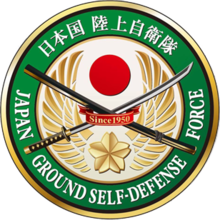 Emblem of the Japan Ground Self-Defense Force | |
| Founded | 1 July 1954[1] |
| Country | |
| Type | Army |
| Role | Land warfare |
| Size | 150,000 active personnel |
| Part of | |
| Garrison/HQ | Ichigaya, Shinjuku, Tokyo, Japan |
| Colours | Red, White and Gold |
| March | Review March (分列行進曲) |
| Website | www |
| Commanders | |
| Prime Minister of Japan | Shinzō Abe |
| Minister of Defense | Tarō Kōno |
| Chief of Staff, Joint Staff | General Kōji Yamazaki |
| Chief of the Ground Staff | General Gorō Yuasa |
| Insignia | |
| Flag |  |
New military guidelines, announced in December 2010, direct the Japan Self-Defense Forces away from their Cold War focus on the Soviet Union to a new focus on China, especially in respect of the dispute over the Senkaku Islands.
The JGSDF operates under the command of the chief of the ground staff, based in the city of Ichigaya, Shinjuku, Tokyo. The present chief of staff is General Gorō Yuasa (湯浅悟郎). The JGSDF numbered around 150,000 soldiers in 2018.[3]
History
20th century
Japan accepted the Potsdam Declaration in 1945, and, in compliance with Article 9, the Imperial Japanese Army and Imperial Japanese Navy were dismantled. Both were replaced by the United States Armed Forces occupation force, which assumed responsibility for the external defense of Japan.
Despite Douglas MacArthur's strict insistence on Japan having no military or self defence by constitution, Japanese prime minister Hitoshi Ashida amended article 9 of the constitution to allow the creation of military forces in Japan which would operate under the name of self-defence forces. The ground, naval and air self-defence forces all originate from this amendment, rendering the occupation's desire for a demilitarised Japan rather moot.[4]
Under the terms of the Treaty of Mutual Cooperation and Security between the United States and Japan, United States forces stationed in Japan were to deal with external aggression against Japan while Japanese forces, both ground and maritime, would deal with internal threats and natural disasters. Only after the outbreak of the Korean War did MacArthur authorise the Prime Minister, Shigeru Yoshida, to establish a 75,000 strong National Police Reserve. The next expansion came in 1952, when as a compromise in the face of U.S. calls to build up an army of 350,000, the National Police Reserve was re-titled the National Safety Force and expanded to 110,000.[5]
In 1954, Prime Minister Yoshida impelled the Diet to accept the Defence Agency Establishment and the Self-Defence Force Laws, which explicitly authorised the not-quite-armed-forces to ‘defend Japan against direct and indirect aggression, and when necessary to maintain public order.’[6] On July 1, 1954, the National Security Board was reorganized as the Defense Agency, and the National Security Force was reorganized afterwards as the Japan Ground Self-Defense Force (Army), the Japan Maritime Self-Defense Force (Navy) and the Japan Air Self-Defense Force (Air force), with General Keizō Hayashi appointed as the first Chairman of Joint Staff Council—professional head of the three branches. The enabling legislation for this was the 1954 Self-Defense Forces Act [Act No. 165 of 1954].[1]
That year the actual strength of the Ground, Maritime and Air Self-Defence Forces reached 146,285, armed mainly with U.S. World War II vintage equipment.[7] At least up until the 1970s, the Ground SDF was not built up to the point required to defeat an invasion attempt from the north – informed officials estimated that the officially held two months’ required ammunition would actually likely be used up in a week or less.[8]
For a long period, the Japan Ground Self-Defense Force possessed a dubious ability to hold off a Soviet invasion of Hokkaido. Zbigniew Brzezinski observed in 1972 that it seemed optimized to fight "a Soviet invasion conducted on American patterns of a quarter of a century ago."[9] Three years later in 1975, Osamu Kaihara, the former secretary of the National Defence Council, was reported in U.S. News and World Report that the SDF would have been totally ineffective in any Soviet attack, as the Ground SDF could only fight as an army for three to four days.[10] While the force is now an efficient army of around 150,000,[11] its apparent importance had, until recently, seemingly declined with the end of the Cold War, and attempts to reorient the forces as a whole to new post Cold War missions have been tangled in a series of internal political disputes.
21st century
On March 27, 2004, the Japan Defense Agency activated the Special Operations Group with the mandate under the JGSDF as its Counter-terrorist unit.[12]
In 2015, the Japanese Diet passes a law that allowed for the reinterpretation of Article 9 of the constitution. JSDF personnel train with the American forces in amphibious assault units designed to take outlying islands.[13]
Japan activated its first marine unit since World War II on April 7, 2018. The marines of the Amphibious Rapid Deployment Brigade are trained to counter invaders from occupying Japanese islands along the edge of the East China Sea.[14]
British troops of the Honourable Artillery Company (HAC) exercised together for the first time with Japanese GSDF soldiers in Oyama, Shizuoka prefecture on 2 October, 2018. This also marked the first time in history that foreign soldiers other than Americans exercised on Japanese soil. The purpose was to improve their strategic partnership and security cooperation. Lieutenant General Patrick Sanders said that Japan won't have to fight alone.[15]
The JGSDF and the Indian Army conducted their first joint military exercise in the Indian state of Mizoram from 27 October to 18 November 2018. It's primarily anti-terror drills and improving bilateral cooperation with 60 Japanese and Indian officers.[16]
In March 2019, the Ministry of Defense will establish its first regional cyber protection unit in the Western Army of the Japan Ground Self-Defense Force (JGSDF) to safeguard defense communications from cyber attacks. Such as for personnel deployed on remote islands with no established secure lines.[17]
The Japanese government approved the first ever JSDF dispatch to a peacekeeping operation that's not led by the United Nations. Two JGSDF officers will monitor a cease-fire between Israel and Egypt at the Multinational Force and Observers command in the Sinai peninsula from 19 April until 30 November 2019.[18]
Current deployment
Personnel
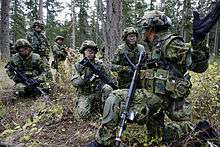
_Flag_-_Orient_Shield_2017_Opening_Ceremony.png)
In 1989, basic training for lower-secondary and upper-secondary academy graduates began in the training brigade and lasted approximately three months. Specialized enlisted and non-commissioned officer (NCO) candidate courses were available in branch schools and qualified NCOs could enter an eight-to-twelve-week officer candidate program. Senior NCOs and graduates of an eighty-week NCO pilot course were eligible to enter officer candidate schools, as were graduates of the National Defense Academy at Yokosuka and graduates of all four-year universities. Advanced technical, flight, medical and command and staff officer courses were also run by the JGSDF. Like the maritime and air forces, the JGSDF ran a youth cadet program offering technical training to lower-secondary school graduates below military age in return for a promise of enlistment.
Because of population density and urbanization on the Japanese islands, only limited areas are available for large-scale training, and, even in these areas, noise restrictions are extensive. The JGSDF has adapted to these conditions by conducting command post exercises, map manoeuvres, investing in simulators and other training programs, as well as conducting live fire exercises overseas at locations such as the Yakima Training Center in the United States.
The JGSDF has two reserve components: the rapid-reaction reserve component (即応予備自衛官制度) and the main reserve component (一般予備自衛官制度). Members of the rapid-reaction component train 30 days a year. Members of the main reserve train five days a year. As of December 2007, there were 8,425 members of the rapid-reaction reserve component and 22,404 members of the main reserve component.[19]
Equipment
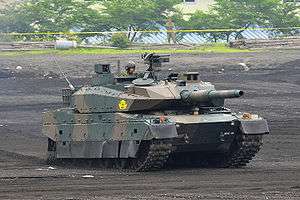
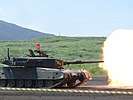 Type 90 Main Battle Tank
Type 90 Main Battle Tank_left_front_view_at_Camp_Nihonbara_October_1%2C_2017_02.jpg) Type 16 Maneuver Combat Vehicle
Type 16 Maneuver Combat Vehicle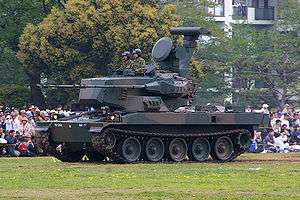


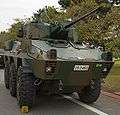
- JGSDF AH-64D & AH-1S
.jpg)
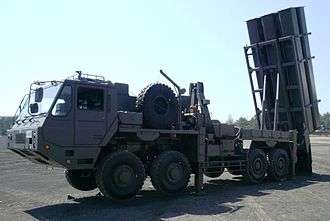
Organisation
Major Command
.png)
Armies
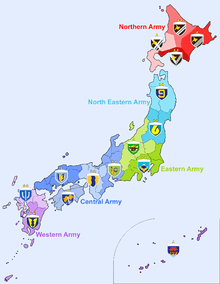




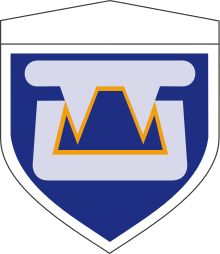
Division
JGSDF currently has 9 active duty divisions (1 armored, 8 infantry)


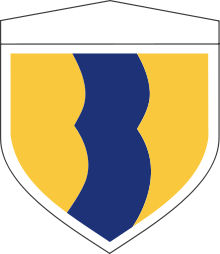
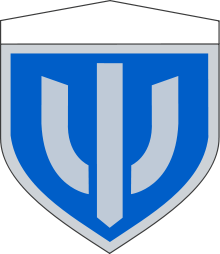


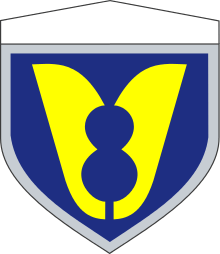

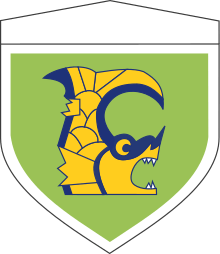
Brigade
the JGSDF currently has 8 combat brigades:
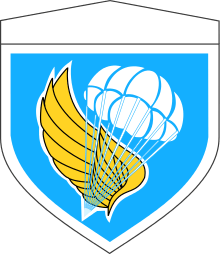
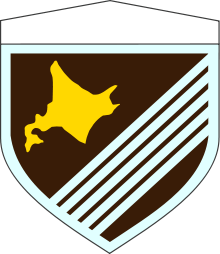

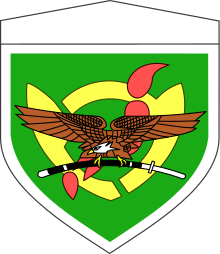
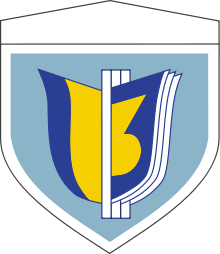

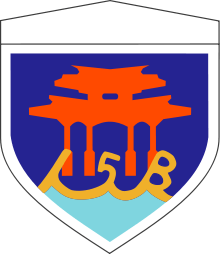
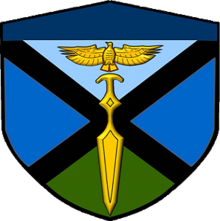
JGSDF divisions and brigades are combined arms units with infantry, armored, and artillery units, combat support units and logistical support units. They are regionally independent and permanent entities. The divisions strength varies from 6,000 to 9,000 personnel. The brigades are smaller with 3,000 to 4,000 personnel.
The JGSDF currently has 9 combat support brigades:
- 1st Artillery Brigade, at Camp Kita Chitose in Chitose, Hokkaido Prefecture
- 1st Helicopter Brigade, at Camp Kisarazu in Kisarazu, Chiba Prefecture
- 1st Anti-Aircraft Artillery Brigade, at Camp Higashi in Chitose, Hokkaido Prefecture
- 2nd Anti-Aircraft Artillery Brigade, at Camp Iizuka in Iizuka, Fukuoka Prefecture
- 1st Engineer Brigade, at Camp Koga in Koga, Ibaraki Prefecture
- 2nd Engineer Brigade, at Camp Funaoka in Shibata, Miyagi Prefecture
- 3rd Engineer Brigade, at Camp Eniwa in Eniwa, Hokkaidō Prefecture
- 4th Engineer Brigade, at Camp Okubo in Uji, Kyoto Prefecture
- 5th Engineer Brigade, at Camp Ogōri in Ogōri, Fukuoka Prefecture
Other units
- Other Units and Organizations
- Material Control Command
- Ground Research & Development Command
- Signal Brigade
- Military Police
- Military Intelligence Command
- Ground Staff College
- Ground Officer Candidate School
- Special Forces Group
.jpg)
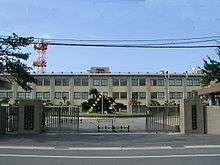
Ranks
Officers(幹部)
| NATO code | OF-9 | OF-8 | OF-7 | OF-5 | OF-4 | OF-3 | OF-2 | OF-1 | |
|---|---|---|---|---|---|---|---|---|---|
| Rank | 陸将 (統合幕僚長および陸上幕僚長) | 陸将 | 陸将補 | 1等陸佐 | 2等陸佐 | 3等陸佐 | 1等陸尉 | 2等陸尉 | 3等陸尉 |
| English translation | General | Lieutenant general | Major general | Colonel | Lieutenant colonel | Major | Captain | First lieutenant | Second lieutenant |
| Insignia Type A (甲階級章) |
.svg.png) | .svg.png) | .svg.png) |
.svg.png) | .svg.png) | .svg.png) |
.svg.png) | .svg.png) | .svg.png) |
| Insignia Type B (乙階級章) |
.svg.png) | .svg.png) | .svg.png) |
.svg.png) | .svg.png) | .svg.png) |
.svg.png) | .svg.png) | .svg.png) |
| Insignia Miniature Type (略章) |
.svg.png) | .svg.png) | .svg.png) |
.svg.png) | .svg.png) | .svg.png) |
.svg.png) | .svg.png) | .svg.png) |
Warrant Officer & Enlisted(准尉および曹士)
| NATO code | OR-9 | OR-8 | OR-7 | OR-6 | OR-5 | OR-3 | OR-2 | OR-1 | OR-D |
|---|---|---|---|---|---|---|---|---|---|
| Rank | 准陸尉 | 陸曹長 | 1等陸曹 | 2等陸曹 | 3等陸曹 | 陸士長 | 1等陸士 | 2等陸士 | 自衛官候補生 |
| English translation | Warrant officer | Sergeant major | Master sergeant | Sergeant first class | Sergeant | Leading private | Private first class | Private | Self defense official cadet |
| Insignia Type A (甲階級章) |
.svg.png) | .svg.png) | .svg.png) | .svg.png) | .svg.png) |
.svg.png) | .svg.png) | ||
| Insignia Type B (乙階級章) |
.svg.png) | .svg.png) | .svg.png) | .svg.png) | .svg.png) |
.svg.png) | .svg.png) | .svg.png) | .svg.png) |
| Insignia Miniature Type (略章) |
.svg.png) | .svg.png) | .svg.png) | .svg.png) | .svg.png) |
.svg.png) | .svg.png) | No insignia |
See also
References
- "Japan Self-Defense Force | Defending Japan". Defendingjapan.wordpress.com. Archived from the original on 2015-02-16. Retrieved 2014-08-03.
- https://japan-forward.com/how-to-secure-japan-put-premium-on-jsdf-personnel-more-than-hardware/
- IISS Military Balance 2018, Routledge, London, 2018. p.271
- Fumiko Sasaki (26 July 2012). Nationalism, Political Realism and Democracy in Japan: The thought of Masao Maruyama. Routledge. p. 136. ISBN 978-1-136-31378-3. Retrieved 24 May 2013.
- Frank Kowalski, An Inoffensive Rearmament: The Making of the Postwar Japanese Army Archived 2016-01-13 at the Wayback Machine, Naval Institute Press, 2014, p.72
- Raymond L. Brown, ‘Japan’s Army and the Modern Japanese Military System,’ RUSI Journal, December 1978, p.34
- Boei nenkan (Tokyo, 1955), pp.227-247 quoted in Weinstein chapter in James H. Buck (ed.), The Modern Japanese Military System, Sage Publications, Beverly Hills/London, 1975, p.45
- Weinstein chapter in James H. Buck (ed.), The Modern Japanese Military System, Sage Publications, Beverly Hills/London, 1975, p.47
- Zbigniew Brzezinski, The Fragile Blossom (Harper, 1972) p.95, in James H. Buck, ‘The Japanese Military in the 1980s, in James H. Buck (ed.), The Modern Japanese Military System, Sage Publications, Beverly Hills/London, 1975, p.220
- US News and World Report, March 24, 1975, p.34, in James H. Buck, ‘The Japanese Military in the 1980s,’ in James H. Buck (ed.), The Modern Japanese Military System, Sage Publications, Beverly Hills/London, 1975, p.220
- IISS 2010, pp. 408–411
- [site=http://www5f.biglobe.ne.jp/~sbu/DATABASE-JAPAN.htm "Unknown"] Check
|url=value (help). Retrieved March 31, 2020. - "An article in The Economist dated Nov 20, 2017". Archived from the original on November 21, 2017. Retrieved November 21, 2017.
- Kubo, Nobuhiro Japan activates first marines since WW2 to bolster defenses against China Archived 2018-08-02 at the Wayback Machine. April 7, 2018. Reuters. Retrieved August 2, 2018
- "British troops join forces with Japanese for first time on their soil amid North Korea tensions". The Telegraph. 2 October 2018. Archived from the original on 2018-10-12. Retrieved 18 October 2018.
- "India-Japan military exercise begins in Mizoram". Moneycontrol.com. 1 November 2018. Archived from the original on 2018-11-02. Retrieved 6 November 2018.
- "Japan to create first regional counter-cyberattack unit in GSDF's Western Army". The Mainichi. 20 August 2018. Retrieved 26 August 2018.
- "Japan approves plan to send JSDF officers to Sinai, on first non-U.N. peacekeeping mission". The Mainichi. 2 April 2019. Archived from the original on 2 April 2019. Retrieved 3 April 2019.
- Archived March 9, 2010, at the Wayback Machine
External links
| Wikimedia Commons has media related to Japan Ground Self-Defense Force. |